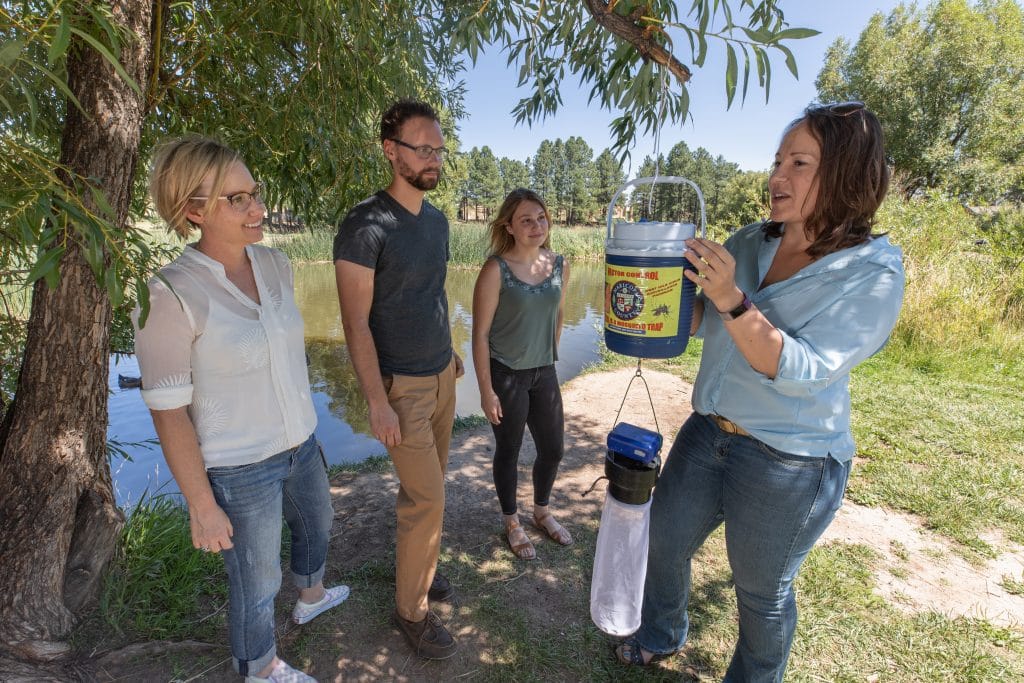Sept. 13, 2019
After sequencing more than 400 different genomes of the West Nile Virus, an NAU scientist discovered the two reports of West Nile Virus in Coconino County came from two different places. One migrated north from the Phoenix area. The other is a bit more of a mystery.
It started with samples from throughout the western United States arriving at the lab of evolutionary biologist Crystal Hepp, who works with both the School of Informatics, Computing, and Cyber Systems and the Pathogen and Microbiome Institute at Northern Arizona University. She collaborates with a dozen different public health departments throughout the West. They send her West Nile (WNV) samples found in their areas, and her team sequences the viral genomes and analyzes the data to reconstruct each sample’s family tree, which allows her to determine how the virus is moving over time and throughout the region.
In this case, Coconino County Health Department sent her the two samples, one found in mosquitoes at Lake Mary and one in the Cheshire area, both in late August. Hepp sequenced the genomes of the virus strains, compared them to the virus strains she’d sequenced from other areas, and found that the two virus strains did not result from local circulation of the virus, meaning they were not transmitted among birds and mosquitoes in the county. The Cheshire strain is closely related to strains circulating in Maricopa County, while the Lake Mary strain is most closely related to a strain her team sequenced from Montana in 2018, though the Lake Mary strain showed several different mutations from the Montana strain.
This was unexpected, Hepp said. It’s also likely a good thing for Coconino County.
“We often think the simplest answer is the most likely answer,” she said. “It would have made sense if these two strains, separated by only 10 miles, were due to the same importation event. From a public health perspective, finding that these two strains are from two different places is good news. If they were closely related, it would mean that WNV had likely been cycled through birds and mosquitoes across 10 miles of Coconino County. We hope that the two separate introductions have just been cycling in the very localized geographic locations they were found, rather than across 10 miles, and that they just fade out.”
Hepp’s lab is a leader in the effort to better understand how the West Nile Virus circulates in the American Southwest. Her public health partners make the initial diagnosis, then send her strains to determine whether the virus originated. Knowing and mapping those data can help governments better predict and prepare for the possibility of West Nile in their areas. Those partners include:
- Maricopa County Environmental Services, Vector Control Division
- Arizona Department of Health Services
- Yuma County Pest Abatement District
- Coachella Valley District Vector Control
- Southwestern Mosquito Abatement and Control District
- Utah Department of Health
- Washington State Department of Health
- Montana Department of Public Health & Human Services
- Coconino County Health Department
- Southern Nevada Health District
This research includes undergraduate students Daryn Erickson, Breezy Brock, Samuel Poidmore and Majesty Greer-Gipson; research specialist Jill Cocking; graduate student Chase Ridenour; Krystal Sheridan and Heidie O’Neill from the PMI sequencing core as well as Darrin Lemmer, Mike Valentine and Dave Engelthaler from the Translational Genomics Research Institute.
“We are very interested in understanding the connectivity among strains circulating in the Southwest,” Hepp said. “This is allowing us to determine, for example, the WNV situation in Maricopa County is for other southwestern locations. WNV from Maricopa County has additionally spilled over into Washington County, Utah; Riverside County, California; and Yuma County, Arizona in the past, and we would like to move forward with a predictive model that could inform counties of risk based on historical patterns and environmental data.”
No human cases of West Nile have been reported in Coconino County since 2010.
West Nile is the most common mosquito-borne illness in the state, although its extent is hard to measure because only about 20 percent of infected people even realize they’re sick. Most of those who do experience symptoms feel like they have the flu, but about one in 150 people infected develop a serious illness such as encephalitis or meningitis, which can be fatal.
In 2018, Hepp received a grant from the Arizona Biomedical Research Centre to investigate the circulation and source locations of West Nile in the state.

Heidi Toth | NAU Communications
(928) 523-8737 | heidi.toth@nau.edu



